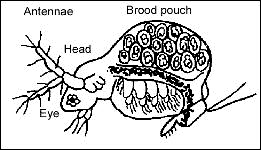

 |
||||||||||||
 |
||||||||||||
| Culture Techniques of Moina: The Ideal Daphnia for Feeding Freshwater Fish Fry | ||||||
| R.W. Rottmann, J. Scott Graves, Craig Watson and Roy P.E. Yanong | ||||||
Daphnia are small freshwater crustaceans commonly called "water fleas". This common name is the result not only of their size, but their short, jerky hopping movement in water. The genera Daphnia and Moina are closely related cladocerans. They occur throughout the world and are collectively known as daphnia. Daphnia have a body consisting of a head and a trunk ( Figure 1 ). The antennae are the main means of locomotion. Large compound eyes lie under the skin on the sides of the head. One of the major characteristics of daphnia is that the main part of the body, the trunk, is enclosed in an external skeleton (carapace). Periodically, they molt or shed their external shell. The brood pouch, where the eggs and embryos develop, is on the dorsal side of the female. In Daphnia , the brood pouch is completely closed, while Moina have an open pouch. 
Figure 1: Adult Moina. There is considerable size variation between the genera. Moina are approximately half the maximum length of Daphnia. Adult Moina (7001,000 µm) are longer than newly-hatched brine shrimp (500 µm) and approximately two to three times the length of adult rotifers. Young Moina (less than 400 µm), however, are approximately the same size or only slightly larger than adult rotifers and smaller than newly-hatched brine shrimp. In addition, brine shrimp die quickly in freshwater. As a result, Moina are ideally suited for feeding freshwater fish fry. Newly-hatched fry of most freshwater fish species can ingest young Moina as their initial food. However, it should be noted that it can be difficult to grade Moina for size. It was found through trials at the UF/IFAS Tropical Aquaculture Laboratory that passing Moina through 500 micron mesh screening tends to fragment the animals to such an extent that they are no longer usable as live food. In aquaria, care must also be taken when determining feeding rates, as Moina can quickly grow too large to be eaten. If these larger Moina become too dense, their "hopping" movements can serve to harass and potentially damage fry. In Singapore, Moina micrura grown in ponds, fertilized with mostly chicken manure or, less frequently, with pig manure, are used as the sole food for fry of many ornamental tropical fish species, with a 9599% survival rate to ¾ inch (20 mm) in length quite common. Unfortunately, there is very little information concerning practical mass culture methods of Moina, and the available information is in mimeograph documents, foreign journals or other scarce publications. Physical and Chemical Requirements Moina appear in high concentrations in pools, ponds, lakes, ditches, slow-moving streams and swamps where organic material is decomposing. They become especially abundant in temporary water bodies which provide them with suitable conditions for only a brief period. Moina are generally quite tolerant of poor water quality. They live in water where the amount of dissolved oxygen varies from almost zero to supersaturation. Moina are particularly resistant to changes in the oxygen concentration and often reproduce in large quantities in water bodies strongly polluted with sewage. Species of Moina have been reported to play an important role in the stabilization of sewage in oxidation lagoons. The ability to survive in oxygen-poor environments is due to their capacity to synthesize hemoglobin. Hemoglobin formation is dependent on the level of dissolved oxygen in the water. The production of hemoglobin may also be caused by high temperature and high population density. Moina are resistant to extremes in temperature and easily withstand a daily variation of 4188° F (531° C); their optimum temperature is 7588° F (2431° C). The high temperature tolerance of Moina is of great advantage for both the commercial fish farmers in the southern U.S. and hobbyists culturing live food at home. more... |
 |
|||||
| About Us :: Message Board :: Chat | |||||
| Library :: Photo Gallery :: Links & Resources :: Breeders & Sponsors :: Merchandise | |||||
| Website designed by: EthanCote.com | © 2001-2004, SimplyDiscus.com. All Rights Reserved. | ||||